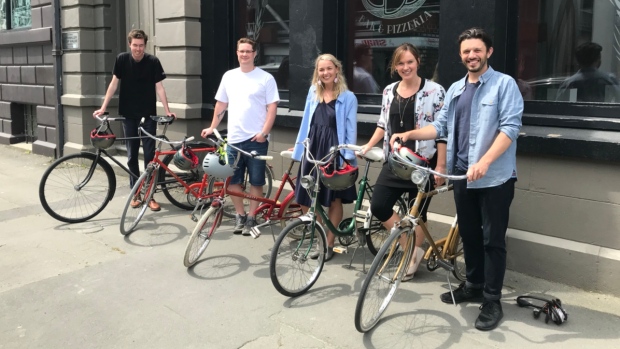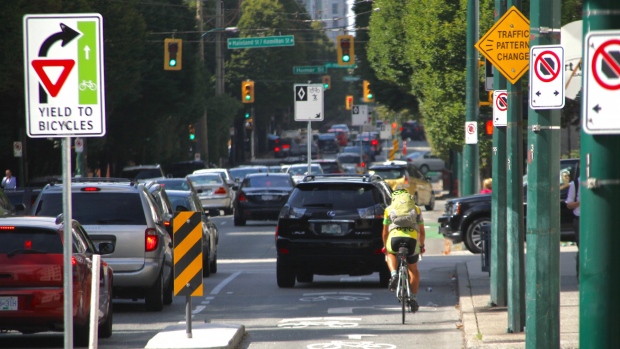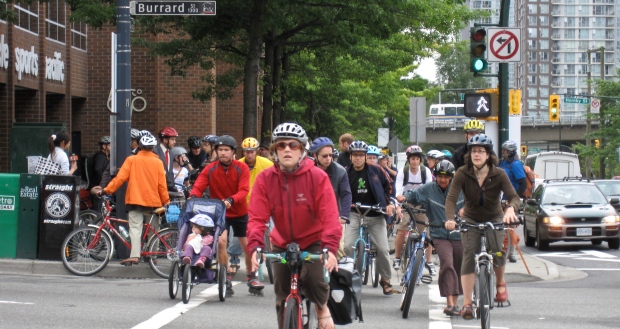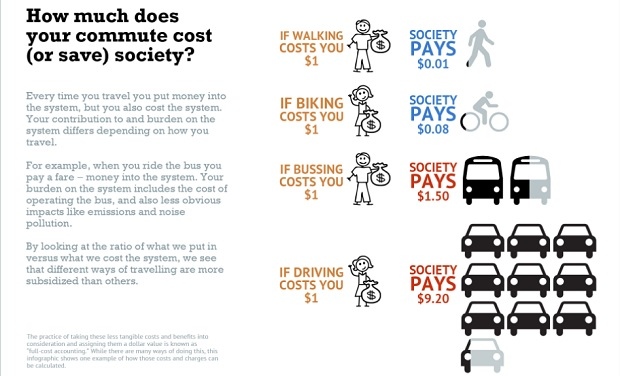The Cross Canada Cycle Tour Society April 2018, Volume 35, Issue #4
President’s Report John Pringle
Bits and Pieces
A few more words on the late Cheryl Campbell. A very good Club turnout for Cheryl’s memorial service. Quite obvious she was well loved and respected, not only by the Club, but by former students. A couple who followed their mentor into teaching were ebullient in their praise. One said she had such an influence on me that, “When you look at me you’re seeing Cheryl.” The other noted Cheryl was her first junior high basketball coach. She went on to play for U Vic and ended up a teacher and coach. Much of her success she credited to Cheryl. I sat next to a former Esquimalt High School vice principal, who extolled Cheryl’s virtues as a school teacher. “One of the best”, he enthused. Interestingly, her brother quoted from an early journal of Cheryl’s and I paraphrase, “I seem to get along with most people except my brother and some of my teachers.” Introspective she was at an early age. “She was a loyal and generous person,” cited her brother. We Club members know her generosity do we not: She gave generously to Victoria Club members as founder of the Monday Pedal Pushers. The title suggests rides for ladies; indeed not. Alex Laird was inveigled to ride one Monday, and immediately became a Cheryl fan.
Of interest is the recent Victoria day-ride offering by Rosa Schuh, a possible Cheryl “incarnate”? She’s recently advertised on the Club website, “Rosa’s Monday Rides”. First ride – April 2nd, Easter Monday. “Speed and spandex not required.” Bring snacks as stops will be made for coffee and lunches. Hill walkers will not walk alone. How cool is this. Do go out and welcome Rosa into the CCCTS fold. And do report if there’s an eerie resemblance to Cheryl.
Way to go Rosa! Thanks so much.
National Capital Region Chapter (NCRC) Success Story. As noted in the March President’s Report, this Chapter has moved quickly to take advantage of our heritage funds. Greater than $5k has been transferred to this well-oiled Chapter. They identified one Ottawa non-profit, “Helping With Bikes”, an affiliate of “Helping with Furniture”, to receive a considerable chunk of our heritage monies via the Ottawa Chapter. This type of community work fits nicely under the CCCTS umbrella. Creators of our constitution would be proud I’m sure. We recently received a very enthusiastic letter from HWB Chief Mechanic and Instructor, Chris Taylor (see a recent website post for more information on him and this project). The monies, he explains, are going, in part, to a seed fund that allows his organization to approach commercial businesses such as Canadian Tire to provide safety attire, e.g. bicycle helmets for HWB clients (could be a refugee, who’s been given a reconditioned bike, but doesn’t have cash to purchase a helmet). As well, a number of Club members are volunteering to refurbish the used bikes. Is this not a perfect community project for CCCTS?
The Comox Valley Chapter is finishing up a similar community-based, CCCTS financially-supported community project. For project details see the Club website. One 2018 CCCTS goal is to see the Victoria and Area Chapter similarly organized, and initiating not only community-based projects, but ones that benefit local Club members. Line up behind Alex folks, and move forward.
“Montréal mulls adopting separate traffic laws for cyclists.” Well dear readers did you ever expect such a newspaper headline (In the Globe and Mail about March 15th, 2018). In fact, it makes complete sense, but there are times when “sense” is in short supply. On a cross Canada ride in 2008, Québec was our favourite province to ride in because the safety of Route Verte. Their thousands of kilometres of bikeways linking the various regions of Québec has been under development since 1996. Velo Québec along with Québec’s Ministry of Transportation have worked together to make this province by far the safest jurisdiction in Canada to cycle in. Furthermore, Montréal is frequently cited amongst the safest municipalities in the world for cyclists.
What are Montréaler’s now contemplating?
The new mayor and her administration are “… pushing to change the rules under which cyclists operate.” If approved, (rules of the road are under the aegis of the Province and this is where the first rub may come) Montréal would become the largest North American municipality to have separate rules for cyclists. “The shift would reflect the basic reality that bicycles and automobiles are fundamentally different …” Two specific changes are contemplated: First, that cyclists would be allowed to follow rules aimed at pedestrians; and secondly, they “… could treat stop signs as yields.” The latter is known internationally as the “Idaho stop”; named after the State where it has been allowed since 1982. Apparently it was introduced here to prevent scofflaw from plugging the courts. State legislators reasoned that the practice is so common, why not legitimize it? Using it correctly, a cyclist must slow sufficiently to guage the safety of either stopping or continuing through the intersection. Edmonton council voted in favour of such a regulation in 2016. Who knew?
2018 Tours and Hub and Spokes. Thanks are extended to both the Tours and H&S directors and the individual tour and H & S leaders for providing a most interesting series of events for 2018. View the website for details.
We have two new H&S for 2018: South Okanagan and Manitoulin Island, organized respectively by relatively new Club members, Doug Glodek of Penticton and Angus MacIntosh of Manitoulin Ontario and Comox BC. Thanks Lads for stepping forward.
There are six tours offered, and again, view the website for details. The Hawaii tour was over-booked. Bruce Daykin worked with Maureen Weston, Delores Franz Los and Max McClanahan to organize a second back-to-back tour with Aeron Ryan kindly stepping forward as tour leader (November 15th to 29th). Please note: Six more riders, at time of writing, can yet be accommodated on this popular tour.
It is always discouraging when a tour leader(s), having prepared a sound tour proposal, fails to attract sufficient riders to make the tour financially viable. Sadly this happened for the Oregon Coast & Willamette Valley Scenic Bikeway tour organized by experienced tour leaders Brian Collier and Donna Kerkhoven. These folks led a successful tour of Ireland in 2017, and were pumped to lead another. They chose an iconic route; cyclists come worldwide to experience it. The tour experienced a couple of scheduling conflicts, and the advent of a second Oregon tour. Let’s hope Brian and Donna will consider offering it in 2019 when they could have their choice of dates and with no scheduling conflicts – guaranteed.
Addendum to “Helping with Bikes”
- HWB is a subset of Helping with Furniture (HWF) which has been going for over 15 years and helps families that have been referred to them by social services to equip whatever housing they are going into;
- In assessing the needs of any given family, besides for furniture, dishes, cutlery, etc., the assessors, also volunteers, ask about bikes –the need, the use they will be put to (commuting, going to school, main transportation, whatever), the height and weight of the individual(s) and a few other details;
- Every Wednesday evening after 6 pm, another group of volunteers loads up a donated truck with the items designated for the families to be set up that night. Usually they do four families and often work past midnight. Not all families request bikes of course, but HWB works on any that are needed by the following Wednesday so that they can be delivered at the same time as all the other items;
- To do this requires a very good system of tracking needs, progress, parts required (new or recycled from donated bikes), what remains to be done etc. on the list of bikes identified for that week;
- All work is done by volunteers whenever they are available, and they expect to be providing at least 200 bikes this year, so it is quite the operation;
- A big concern on the part of Chris is that while they do the bikes, the recipients should have helmets and locks yet often do not have the money to purchase these, so a part of our contribution was aimed at giving HWB some funding to allow them to go to different retailers to encourage them to provide these necessary items at a drastic discount, working with HWB.
- We had a good but older road bike that was surplus to our needs, so we handed it over to Chris along with the cheque.

Upcoming Tours
Upcoming Hub and Spoke
2018 South Okanagan Hub & Spoke
2018 Manitoulin Island Hub & Spoke
Welcome New Members
| Kathy | Haigh | Comox | BC |
| Paula | Marinigh | Ottawa | ON |
| Paul | Turner | Ottawa | ON |
| Jane | Huijsmans | Victoria | BC |
| Richard | Huijsmans | Victoria | BC |
| Karen | Shigeishi-Waite | Ottawa | ON |
| Selen | Sierra-Soulard | Ottawa | ON |
| Jennie | Sparkes | Victoria | BC |
| Barry | Howell | White Rock | BC |
| Nancy | Luitwieler | Ottawa | ON |
| Ron | Planden | Saanichton | BC |
| Linda | Parsons | Ottawa | ON |
| Phil | Valois | Ottawa | ON |
| Patricia | Danforth | Salmon Arm | BC |
| Billy | Knutson | Surrey | WA |
| Margaret | Phelan | Victoria | BC |
| Dave | Audette | Ottawa | ON |
| Anne | Sanderson | Victoria | BC |
Using Red Light Cameras For Speed Enforcement Will Save Lives
Great news! The BC Government will upgrade red light cameras to catch speeders at dangerous intersections. This is a badly needed measure that will reduce crashes making intersections safer for people cycling, walking and driving.
Please write the Premier and ministers supporting this and other safety improvements. Encourage them to focus on reducing speeds at intersections where a lot of people are walking and cycling.
Send them a quick email from:
https://www.bccc.bc.ca/red_light_camera_speed_enforcement
Richard Campbell
Executive Director(BCCC)
How Exercise in Old Age Prevents the Immune System from Declining
Fergus Walsh, Medical correspondent, 8 March 2018, BBC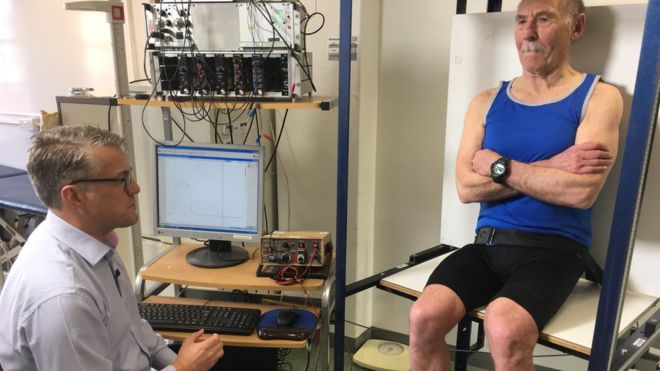
Professor Norman Lazarus, aged 82, has the immune system of a 20 year old
Doing lots of exercise in older age can prevent the immune system from declining and protect people against infections, scientists say.
They followed 125 long-distance cyclists, some now in their 80s, and found they had the immune systems of 20-year-olds.
Prof Norman Lazarus, 82, of King’s College London, who took part in and co-authored the research, said: “If exercise was a pill, everyone would be taking it.
“It has wide-ranging benefits for the body, the mind, for our muscles and our immune system.”
The research was published in the journal Aging Cell.
Prof Janet Lord, director of the Institute of Inflammation and Ageing, at the University of Birmingham, and co-author of the research, said: “The immune system declines by about 2-3% a year from our 20s, which is why older people are more susceptible to infections, conditions like rheumatoid arthritis and, potentially, cancer.
“Because the cyclists have the immune system of a 20-year-old rather than a 70- or 80-year-old, it means they have added protection against all these issues.”
The researchers looked at markers in the blood for T-cells, which help the immune system respond to new infections.
These are produced in the thymus, a gland in the chest, which normally shrinks in size in adulthood.
‘Out of puff’
They found that the endurance cyclists were producing the same level of T-cells as adults in their 20s, whereas a group of inactive older adults were producing very few.
The researchers believe that being physically active in old age will help people respond better to vaccines, and so be better protected against infections such as flu.
Steve Harridge, co-author and professor of physiology at King’s College London, said: “Being sedentary goes against evolution because humans are designed to be physically active.
“You don’t need to be a competitive athlete to reap the benefits – or be an endurance cyclist – anything which gets you moving and a little bit out of puff will help.”
Prof Harridge and Prof Lazarus believe that highly physically active older people represent the perfect group in which to analyse the true effects of biological ageing.
A separate paper in Aging Cell found that the cyclists did not lose muscle mass or strength, and did not see an increase in body fat – which are usually associated with ageing.
I met a dozen of the cyclists, on a morning ride in Surrey. Despite the bitter cold, they were universally cheerful, and clearly used to riding in all weathers.
They are members of Audax, a long-distance cycling organisation that organises events ranging from 100km to 300km.
The older members – in their 80s – say they do only the “short” 100km (62-mile) rides, but this is still highly impressive.
So why do they do it?
Pam Jones, 79, told me: “I do it for my health, because it’s sociable, and because I enjoy the freedom it gives you.”
Brian Matkins, 82, said: “One of the first results I got from the medical study was I was told my body fat was comparable to that of a 19-year-old.”
Aged just 64, Jim Woods, is a comparative youngster in the group. He averages 100 miles a week on his bike, with more during the summer.
He said: “I cycle for a sense of wellbeing and to enjoy our wonderful countryside.”
Cycling 60 miles or more may not be your idea of fun, but these riders have found something that gives them pleasure, which is a key reason why they continue
Are cash incentives a good way to get commuters onto bikes?
A Christchurch advertising agency is turning drivers into cyclists by offering $10 per day to bike to work
By Karin Larsen, CBC News Posted: Mar 18, 2018
Tim Chesney (far right) launched a pay-for-pedal incentive that helped persuade most of the staff at his New Zealand advertising agency to become bike commuters.
A New Zealand company is close to converting its entire workforce from car commuters to bike commuters.
The secret: cold, hard cash.
Christchurch advertising and creative agency Make Collective launched the pay-for-pedal initiative last month, offering staff $5 per day for biking to and from work. The amount doubles to $10 per day if an employee cycles more than half of their annual work days.
“I felt like [money] is the most obvious incentive,” said Make Collective director Tim Chesney, who devised the scheme.
Carrot versus stick
“You know the carrot and stick thing? The reasons everyone thinks they should exercise are more on the stick side — people think, ‘I don’t want to get sick or I don’t want to die young.’
“But it’s not often you come across an incentive on the carrot side. And that’s why the money. If you wake up and it’s cold out or you’re tired, there’s a slight hump to get over,” Chesney said in a phone interview from New Zealand.
“But then you think if I do this I get $10.”
A cyclist navigates the bikeway on Smithe Street in downtown Vancouver. (Rafferty Baker/CBC)
In Christchurch, five of the six staff at Make Collective have taken to two wheels, and the sixth is “working on it.” According to Chesney, the program will cost the company approximately $12,000 a year.
‘Not really that much’
‘If you look at it on a per-staff basis, it’s about $1,000 to $2,000 per person. In the context of a $50,000-to-$100,000-a-year job, it’s not really that much,” he said.
In Vancouver, a number of businesses offer employees cycling incentives, although none appear to be offering cash.
Vancity has a rebate program, which provides up to $1,000 for the purchase of a new bike or e-bike. The tech company, SAP, reimburses employees for the cost of the local bike share program.
And more generally, a few years back, BIKO, arrived in the city, offering to turn kilometres logged on the BIKO app into free craft beer and food.
Vancouver’s bike infrastructure is one reason some commuters choose to cycle. (Ariane Colenbrander/Flickr)
Navdeep Chhina of the cycling advocacy group HUB, says any program that encourages cycling is worthwhile. However, his group believes building infrastructure like separated bike lanes is the best way to get people out of their cars.
‘Take away free parking’
“Getting people to change that [driving] mindset is much more important than giving monetary incentives,” said Chhina. “A bigger incentive would be to take away the free parking that some businesses offer.”
Chhina points to a recent data journalism project by Discourse Media that compares the real costs of commuting by different methods. According to the study, for every dollar spent by a cyclist, society contributes just eight cents in infrastructure spending. However for every dollar spent by a driver, society pays $9.20.
“When more people cycle for transportation, our communities become happier, healthier and safer,” he said.
(Discourse Media/data by George Poulos)
Chesney couldn’t agree more — about his own switch to cycling and about the benefits to his company.
“I was a bit overweight and not very healthy and cycling was a simple way I could put exercise back into my daily life,” he said.
“And I also had a gut instinct…if more people cycled and showed up having got their blood flowing, healthier and unstressed, that would be a good thing.”
Worldwide attention
Since word of the pay-for-pedal scheme got out, Chesney’s been inundated with media requests.
“It’s been crazy. I got an email from Slovenia yesterday. Radio stations in Australia and Colombia are ringing me up.
“My advice for companies who may want to do this is just make sure you have the incentives wired up right,” he said.
“We currently have all able-bodied employees, so that makes it straight forward. If you have a more diverse workplace, you’d really have to think of how to make if fair for everybody.”
Newsbrief
Published at least ten times a year by The Cross Canada Cycle Tour Society, a non – profit organization for retired people and others who enjoy recreational cycling.
Items for the NEWSBRIEF must be received by the 28th of the month. The Editor reserves the right to edit for clarity, brevity and suitability of publication. The views expressed in the “NEWSBRIEF” are not necessarily those of the CCCTS or the Editor.
Submissions for NEWSBRIEF should be emailed to derailler@gmail.com
Please be sure to notify the office of any changes in your personal contact information; be it address, phone or e-mail.

